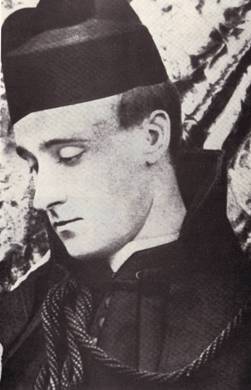

Queer Places:
The King's School, Brook St, Grantham NG31 6RP, UK
St Mary's College, 147 Chester Rd, Sutton Coldfield B73 5BB, UK
61 Cheapside, London EC2V 6AX, UK
15 Cheniston Gardens, Kensington, London W8, UK
69 Broadhurst Gardens, London NW6 3QR, UK
Isola di San Michele, 30135 Venezia VE, Italia
 Frederick William Rolfe, better known as Baron Corvo, and also calling
himself 'Frederick William Serafino Austin Lewis Mary Rolfe',[1]
(22 July 1860 – 25 October 1913), was an English writer, artist, photographer
and eccentric. Ballade of Boys Bathing (1890), St William of Norwich (1892, co-authored with
John Gambril Nicholson) and ‘Stories Toto Told Me (1896) are cited as examples in Sexual Heretics: Male Homosexuality in
English Literature from 1850-1900, by Brian Reade. He appears as Enif in
R.H. Benson's Initiation
(1914).
Frederick William Rolfe, better known as Baron Corvo, and also calling
himself 'Frederick William Serafino Austin Lewis Mary Rolfe',[1]
(22 July 1860 – 25 October 1913), was an English writer, artist, photographer
and eccentric. Ballade of Boys Bathing (1890), St William of Norwich (1892, co-authored with
John Gambril Nicholson) and ‘Stories Toto Told Me (1896) are cited as examples in Sexual Heretics: Male Homosexuality in
English Literature from 1850-1900, by Brian Reade. He appears as Enif in
R.H. Benson's Initiation
(1914).
Rolfe was born in Cheapside, London, the son of a piano manufacturer. He left school at the age of fourteen and became a teacher. He taught briefly at The King's School, Grantham, where the then headmaster, Ernest Hardy, later principal of Jesus College, Oxford, became a lifelong friend.
He converted to Roman Catholicism in 1886 and was confirmed by Cardinal Manning. With his conversion came a strongly-felt vocation to the priesthood, which persisted throughout his life despite being constantly frustrated and never realised. In 1887 he was sponsored to train at St Mary's College, Oscott near Birmingham and in 1889 was a student at the Scots College in Rome, but was thrown out by both due to his inability to concentrate on priestly studies, his "reputation as a pederast",[2] and his erratic behaviour.
At this stage he entered the circle of the Duchess Sforza Cesarini, who, he claimed, adopted him as a grandson and gave him the use of the title of "Baron Corvo". This became his best-known pseudonym; he also called himself "Frank English", "Frederick Austin" and "A. Crab Maid", among others. More often he abbreviated his own name to "Fr. Rolfe" (an ambiguous usage, suggesting he was the priest he had hoped to become).
Rolfe spent most of his life as a freelance writer, mainly in England but eventually in Venice. He lived in the era before the welfare state, and relied on benefactors for support. But he had an argumentative nature and had a tendency to fall out spectacularly with most of the people who tried to help him and offer him room and board. Eventually, out of money and out of luck, he died in Venice from a stroke on 25 October 1913. He was buried on the Isola di San Michele, Venice.[3]
Rolfe's life provided the basis for The Quest for Corvo by A. J. A. Symons, an "experiment in biography" regarded as a minor classic in the field. This same work reveals that Rolfe had an unlikely enthusiast in the person of Maundy Gregory.
The King's School, Brook St, Grantham
Rolfe was entirely comfortable with his homosexuality and associated and corresponded with a number of other gay Englishmen. Early in his life he wrote a fair amount of idealistic but mawkish poetry about boy martyrs and the like. These and his Toto stories contain pederastic elements, but the young male pupils he was teaching at the time unanimously recalled in later life that there had never been any hint of impropriety in his relations with them. As he himself matured, Rolfe's settled sexual preference was for late adolescents. Towards the end of his life he made his only explicit reference to his specific sexual age preference, in one of the Venice letters to Charles Masson Fox, in which he declared: "My preference was for the 16, 17, 18 and large."[4] Grant Richards, in his Memories of a Misspent Youth (1932), recalls "Frederick Baron Corvo" at Parson's Pleasure in Oxford – where scholars could bathe naked – "surveying the yellow flesh tints of youth with unbecoming satisfaction".
Those of whom it is either speculated or surmised that they had sexual relations with Rolfe – Aubrey Thurstans, Sholto Osborne Gordon Douglas, John 'Markoleone', Ermenegildo Vianello and the other Venetian gondoliers – were all sexually mature young men between the ages of sixteen and twenty-one (with the exception of Douglas,[5] who was considerably older). The idealised young men in his fiction were of a similar age.[6]
In 1904, soon after his ordination as a Roman Catholic priest, the convert Robert Hugh Benson formed a chaste but passionate friendship with Rolfe. For two years this relationship involved letters "not only weekly, but at times daily, and of an intimate character, exhaustingly charged with emotion." There was a falling out in 1906, and Benson satirised Rolfe in his novel The Sentimentalists. Rolfe returned the favor a few years later, putting a caricature of Benson named "Bobugo Bonsen" in a book named Nicholas Crabbe. Their letters were subsequently destroyed, probably by Benson's brother.[7]
Rolfe sought to characterise the relationships in his fiction as examples of 'Greek love' between an older man and an ephebe, and thus endow them with the sanction of the ancient Hellenic tradition familiar to all Edwardians with a classical education.
My published books: